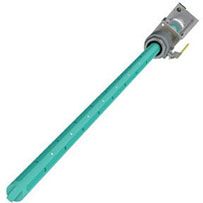Electromagnetic Coils in Flow Rate Measurements
Published on by Water Network Research, Official research team of The Water Network in Technology
Brad Buecker, a senior technical publicist with ChemTreat, outlines several examples of water utilization in power plants (particularly flow rate measurement) and provides information regarding new technologies that address these issues.
"A critical issue in the power industry is steam surface condenser performance, in which the condenser, as its name implies, converts turbine exhaust steam into condensate for return to the boiler. This process improves the thermodynamic efficiency of the Rankine cycle by nearly one-third over what it would be if the steam were not condensed" - states Buecker and then provides an explanation of how this issue could be treated on site.
He sees a solution to this problem in technology that utilizes the property of electromagnetic flow induction, per principles first developed in the 19th century by the towering experimental physicist and chemist Michael Faraday.
"Electromagnetic coils installed inside of the sensor produce magnetic fields that are influenced by flowing water. Stainless steel electrode pairs on the outside of the sensor collect the induced voltage generated by the water flow. Each voltage signal is transmitted to a converter that calculates an average flow velocity. The converter then multiplies this average velocity by the pipe cross-sectional area to produce a volumetric flow rate", writes Buecker.

McCrometer FPI Mag® Flow Meter sensor, Image source: mccrometer.com
"Electromagnetic coils installed inside of the sensor produce magnetic fields that are influenced by flowing water. Stainless steel electrode pairs on the outside of the sensor collect the induced voltage generated by the water flow. Each voltage signal is transmitted to a converter that calculates an average flow velocity. The converter then multiplies this average velocity by the pipe cross-sectional area to produce a volumetric flow rate", adds the author.
The design and mode of operation of the instrument shown above offer several distinct advantages including:
- it does not require a long straight run of pipe either upstream or downstream — an issue that is often a bane with other flow meters.
- the instrument can be hot-tapped into existing piping, such that an equipment shutdown or unit outage is not necessary for installation.
- the instrument is enclosed in a high-strength, stainless-steel body for structural integrity.
- the instrument signals can be directly transmitted to the plant’s distributed control system (DCS) for a continuous display of real-time data, and also for direct incorporation into heat exchanger efficiency algorithms.
Read more about cooling water flow measurements in Buecker's article " Flow Measurement Challenges and Solutions " on mccrometer.com.
Media
Taxonomy
- Cooling Boiler & Wastewater
- Cooling Systems
- Pumping System Design
- Flowmetering
- Pipes Design
- Energy
- Meter Data Collection
- Water Safety
- Water Utility
- Infrastructure
- Civil Engineering
- Meters
- Pumps
- Installations
- Pumps Installation
- Condition Assessment
- Advanced Metering Infrastructure
- Utility Pipe Network
- Flow Meters
- Power Generation
- Power Plants
- Wastewater Heat Recovery
- Pipes and Pipelines